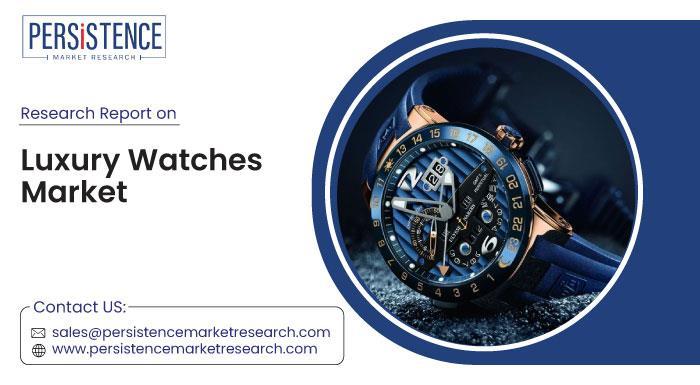The global luxury watches market is evolving at a steady pace, marked by a strong resurgence of mechanical classics, increasing digital engagement, and the ever-growing demand for rare and innovative timepieces. According to a recent report by Persistence Market Research, the market is projected to rise from USD 45,007.0 million in 2025 to USD 61,190.1 million by 2032, registering a compound annual growth rate (CAGR) of 4.5%

�������������������� �������� ������������: https://www.persistencemarketresearch.com/market-research/luxurywatches-market.asp
As consumertastes continue to shifttoward high-value, timeless products, the luxury watches sector stands out for its fusion of craftsmanship, technological advancement, and lifestyle appeal. While traditional mechanical watchesremainin highdemand, modern innovations are openingnewavenues for growth and engagement.
Mechanical Timepieces:The EnduringAppealof Tradition
At the heartof the luxury watches marketlies an enduringadmiration formechanical watches. These timepieces symbolize more than just function they represent legacy, precision engineering, and artisanal mastery. Brands like Patek Philippe,Rolex, and Jaeger-LeCoultre are continuingto lead in this category, introducing new models that showcase high complications such as perpetual calendars, moon phases, and tourbillons.
In 2024, Rolex introduced an upgraded Perpetual1908in 950 platinum, featuringan intricate guilloché rice-grain motif dial. This release not only highlights the brand’s commitment to craftsmanship but also reflects growingconsumerdemand forexclusive, heritage-inspired timepieces.
Innovation and Bold Design:Attractingthe NextGeneration
Modern innovation is also takingcenterstage. Leadingwatchmakers are infusingtheircollections with bold aesthetics, cutting-edge materials, and advanced mechanics to appeal to contemporary collectors and youngerdemographics.
A prime example is Richard Mille, which in February 2025 unveiled the RM16-02 AutomaticExtraflat in titanium and Terracotta Quartz TPT®, along with the RM 74-02 Automatic Tourbillon the firstto feature Gold Quartz TPT®. These timepieces push the boundaries of design and performance, reinforcingthe brand’s leadership in modern luxury horology.
Luxury brands are now integrating innovation not just in materials and movement, but also in customerengagementthrough virtualexperiences, AI-driven personalization, and digital storytelling.
Resale MarketBoom: Luxury Watches as InvestmentAssets
Beyond their design and legacy value, luxury watches are increasingly being viewed as investmentgrade assets. The secondary market is thriving, with rare models appreciatingby up to 200% of their original retail price. Platforms such as Chrono24 and WatchBox are spearheading this trend by providingauthenticated resale options, transparentpricing, and seamless userexperiences.
Luxury brands like Rolex, Audemars Piguet, and Richemont have launched certified pre-owned programs, effectively turning what was once a competitive space into a strategic revenue channel These programs enablebrands to controlresale prices,ensureauthenticity, and engagenew customer segments.
This approach is resonating especially with Gen Z and millennials segments that now contribute significantly to market growth. Recentsurveys show that 54% of youngerbuyers have increased their watch spendingin the lasttwo years, and 66% factor in resale value whenmakingpurchasedecisions.
Digital Disruption:The Rise of OnlineSales and Direct-to-ConsumerChannels
Digital commerce has emerged as a majorgrowth engine forthe luxury watch sector. In 2024, online sales accounted for 29.3% of the luxury watch market, with projections suggesting this figure will surpass $6 billion by 2025. The shifttoward direct-to-consumer(DTC) models is empoweringbrands to reclaim control overpricing, customerdata, and brand experience.
Companies are investing heavily in omnichannel strategies, combining the convenience of online shopping with the exclusivity of in-store experiences. For example, Zenith now generates 50% of its sales via DTC channels, exemplifying the market's broader shift toward integrated digital -retail ecosystems.
Still, brick-and-mortar boutiques remain crucial particularly in Asia. In China, for instance, 90% of consumers reportthatvisitingaphysical store is a key factor in theirdecision-makingprocess.
Heritage and Retail Expansion:Legacy Meets Luxury
Global brands are also expandingtheirphysicalpresencein strategicmarkets.In October2024, JaegerLeCoultre opened its flagship boutiqueat WF Central in Beijing, showcasingheritage pieces and newly restored vintage models. This aligns with agrowingtrend toward heritage restoration, which attracts seasoned collectors and reinforces brand equity.
Meanwhile, Rolex continues to scale its production to meet soaring demand. A new manufacturing facility in Bulle, Switzerland, is currently underdevelopmentand expected to be completed by 2029. The initiative aims to close the supply-demand gap following Rolex's record 1.24 million watches produced in 2023, generatingsales of over $11.5 billion.
CounterfeitConcerns:A PersistentIndustry Challenge
Despite positivemomentum,the luxury watchesmarketgrapples withthe proliferation of counterfeit products. An estimated 40 million fake watches enter the market annually exceeding the Swiss watch industry’s official production by 25%. These counterfeits erode brand value and damage customertrust.
Although brands are deploying anti-counterfeiting technologies such as blockchain verification and micro-engraving, counterfeiters are exploiting digital marketplaces and grey market channels. Fake watches now account for 20–35% of counterfeit consumer goods globally. Addressing this issue will require stronger enforcement, consumer education, and greater collaboration between brands and e-commerce platforms.
Regional Dynamics:EastAsiaand Europe Lead
The global marketis driven by two powerhouses EastAsiaand Europe.
East Asia commands the largest share at 32%, fueled by increasing wealth, cultural appreciation for fine horology, and demand for both modern and vintage timepieces. Countries like China, Japan, and South Korea are particularly active markets, with leading brands openingexclusiveboutiques and formingregional partnerships.
Europe, with a 30.2% share, remains the cornerstone of luxury watchmaking, anchored by Switzerland’s renowned expertise. The region benefits from a mature luxury infrastructure, loyal consumer base, and continued innovation from legacy brands like Omega, Cartier, and Vacheron Constantin.
Market Segmentation Overview
The market is segmented based on several key attributes:
By Mechanism:Mechanical, Quartz, Electronic
By Price Range:Below $10,000, $10,000–25,000, Above $25,000
By Purchase Type:New, Pre-owned
By Distribution Channel:OnlineStore, Single Brand Store, Multi-brand Store
By Region:North America, Europe,EastAsia, South Asia&Oceania, LatinAmerica, Middle East and Africa
Competitive Landscape:Dominated by Industry Icons
The luxury watches market is highly consolidated, with Rolex, Patek Philippe, Audemars Piguet, Cartier, and Omega collectively controlling more than 55% of global sales. These brands are continually innovating to maintain their competitive edge through product launches, design evolution, and experientialmarketing.
LookingAhead:A Market Defined by Duality
As luxury watchmakers continue to embrace both mechanical tradition and modern innovation, the global market is poised for long-term growth. Success in the coming years will depend on the ability to balance legacy with modernity offeringtimepieces thatnot only mark the hour but also capture the essence of craftsmanship, design, and timeless value.
